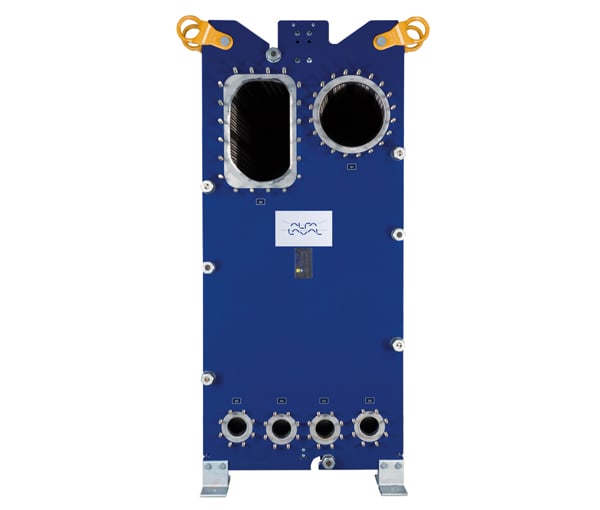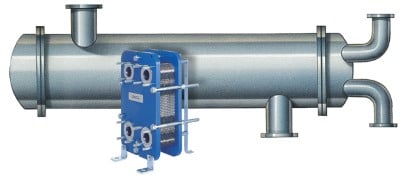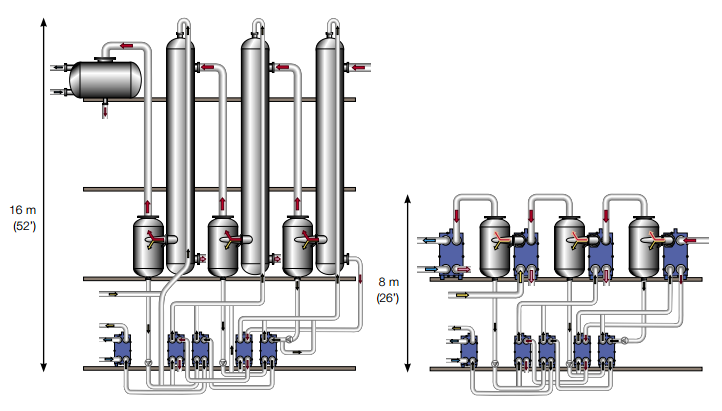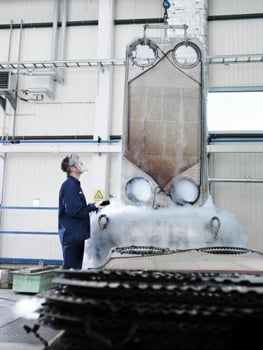
AlfaVap semi-welded heat exchangers are rising film plate evaporators and are suitable when concentration and viscosity of media are high.
AlfaVap’s advantage is that they work also when the temperature differential between the hot and cold fluids approaches as low as 2.5°C (4.5°F) meaning that lower grade steam and more effects in series can be use in an evaporation system compared to the shell-and-tube systems. This saves steam costs.


 The heat transfer area of a gasketed plate-and-frame heat exchanger consists of a series of corrugated plates, assembled between the frame and pressure plates, which retain the design pressure. The sealing between the plates on the AlfaVap alternates between laser welds and gaskets. AlfaVap is tailor-made for evaporation. It has two inlet feed connections located centrally at the bottom of the frame plate and a large outlet for the vapour and concentrate at the top. The heating steam condenses in the welded channels and the evaporating product passes through the gasketed channels.
The heat transfer area of a gasketed plate-and-frame heat exchanger consists of a series of corrugated plates, assembled between the frame and pressure plates, which retain the design pressure. The sealing between the plates on the AlfaVap alternates between laser welds and gaskets. AlfaVap is tailor-made for evaporation. It has two inlet feed connections located centrally at the bottom of the frame plate and a large outlet for the vapour and concentrate at the top. The heating steam condenses in the welded channels and the evaporating product passes through the gasketed channels.
It's important to understand that all gasketed plate heat exchangers are not the same. The features highlighted below are important components to look for in a GPHE, and when combined, these features offer extensive benefits, such as reduced total cost of ownership, higher efficiency and increased staff safety.
A glue free gasket with superior alignment that ensures a perfect seal and trouble-free maintenance. Fastening to the plate is improved by having five fastening points.
Other gasket designs, such as snap-in gaskets, only have one fastening point to the plate. If this one point is lost, there is no gasket fastening function.
A device between the tightening bolt head and the frame that reduces friction forces and makes service easier.
Opening and closing the PHE without bearing boxes is time consuming and increases the risk of paint damage, which can lead to corrosion damage.
The pressure plate must be easy to move and slide along the carrying bar in order to gain access to the plate pack. The most common solution is a roller on top of the carrying bar, making it easy and less time consuming to conduct service. The roller should be made out of metal to be able to carry the weight of the pressure plate.
The mechanical solution of the roller can be more or less robust. The risk is a pressure plate that is jammed and impossible to move when it is time to conduct service.
Keeps the plates aligned during closing of the plate heat exchanger that facilitates service.
Many alignment systems do not close the vertical gap between the carrying bar and the plate, leading to wavy plate packs with leaking problems.

Plate heat exchangers have an essential role in most applications. If they function poorly, they may lead to lower product quality, reduced safety and higher energy costs. And if they fail, they can lead to costly downtime and major losses in production. This makes it important to perform maintenance – and important to do it correctly.